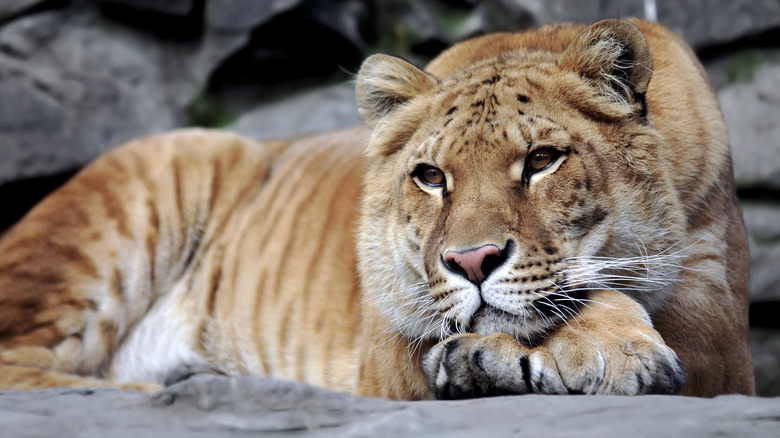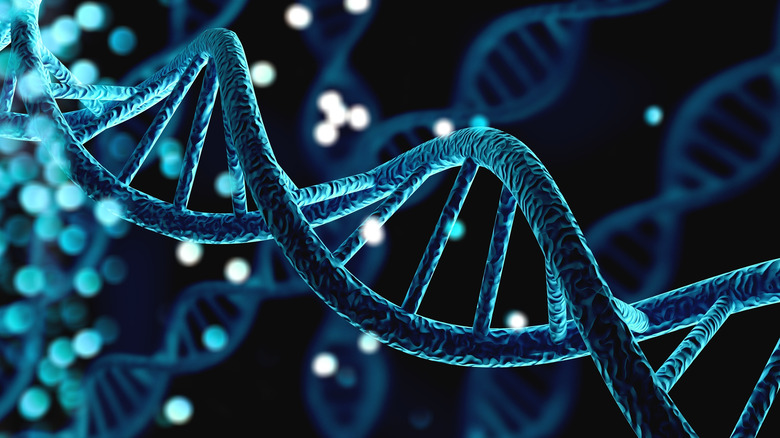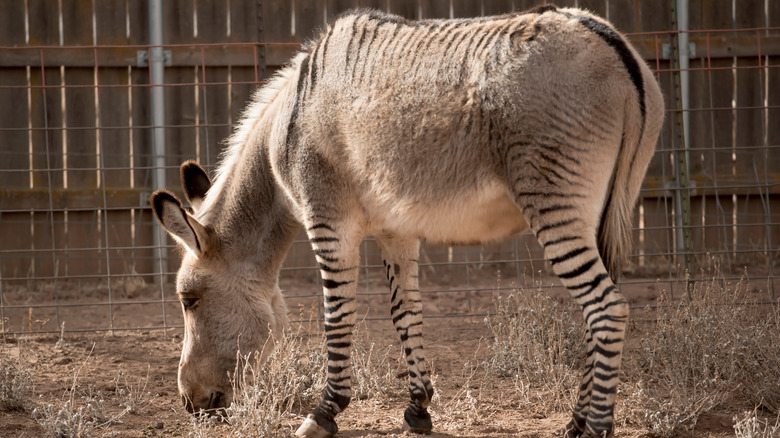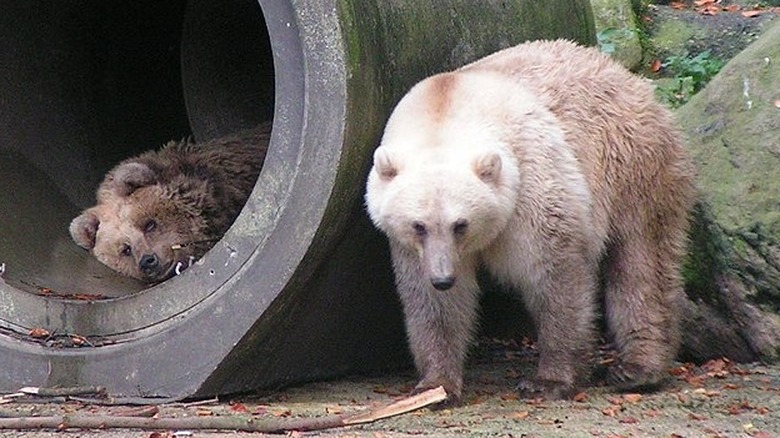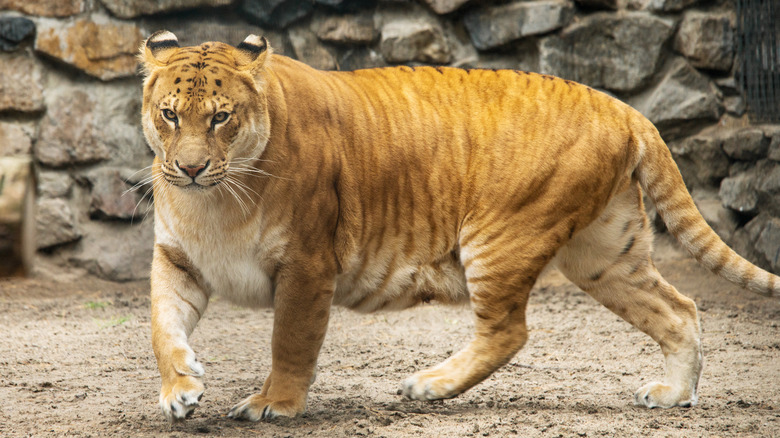Why Hybrid Animals Are More Common Than You Think
As we evolve, we seek to broaden our understanding of the natural world around us. When it comes to all of the creatures in the animal kingdom, there are many unsolved mysteries that we have yet to unravel. In the marvelous age of gene sequencing technology, scientists have been perplexed by the phenomenon of animal hybrids, i.e., two species that have somehow reproduced to create a new subspecies. As we strive to understand this process — hybridization — we stand to gain knowledge of the mechanics of nature like never before. While botanists have documented this process in abundance with plants, our comprehension of cross-breeding species is constantly being challenged (per The Scientist). After all, we may have more Neanderthal DNA than we first realized.
When it comes to animals, this phenomenon isn't as new as first imagined. In 2006, archaeologists discovered a royal burial site in modern-day Aleppo, Syria, that included the enigmatic bones of creatures known as "kungas." Tracing the discovery back to 3,000 B.C.E Mesopotamia, researchers were able to deduce that these donkey-esque skeletons were actually the offspring of female donkeys and male asses, making it the first documented humanmade hybrid ever discovered (via Science Magazine). Today, perceptions and debates around hybrid animals have gained a lot of traction, and discoveries of adaptive new species arising from different animal families are reported all the time (per The Scientist). But, first and foremost, how does hybridization work? What does it reveal about the planet?
How Does it Happen?
To understand how animal hybrids occur, it's important to take a brief biology refresher course. All animals on this floating green and blue marble contain hereditary materials in their bodies called DNA. Our DNA molecules store all of our ancestors' information as well as instructions for our cells, which are necessary for growth, survival, and reproduction (per MedlinePlus). When two animals reproduce, their offspring inherit a combination of traits from both parents. The offspring then develops attributes that are a mash-up of their biological parents' DNA. Offspring of the same species inherit genetic material that is very similar to that of their parents (via Medicine Plus). However, the genetic material inherited by hybrid offspring is more diverse, as the creature's parents are from separate species (per Science News Explores). However, how does this play out in the real world?
Initially, this pattern was considered to be a glitch or an abnormality because these couplings between various animals frequently resulted in an unbalanced number of chromosomes, making the offspring infertile (per National Geographic). The White House witnessed this first-hand in their hilariously fruitless attempts to create the churk, a chicken-turkey hybrid. However, when one species obtains genes from another, the outcome can be detrimental, neutral, or adaptive, according to Quanta. Natural selection tends to eliminate the first, as the hybrid is sometimes too weak to survive or experiences health problems. When it's at a neutral value, inherited genes are carried, but their consequences aren't immediately noticeable. The adaptive genes, on the other hand, are especially interesting to humans because of what they reveal about the power of heredity in shaping evolution and animal behavior.
What Animals Can Hybridize?
Most readers likely have an example in mind when they think of animal hybrids. The big cat crossovers between lions and tigers, ”ligers” or ”tigons”, are among the most well-known animal hybrids, although these only occur in captivity. The five members of the "big cat" family — the leopard, tiger, lion, snow leopard, and jaguar — have been able to interbreed for millions of years, as per Quanta. This is made feasible since all of these species share not only a common ancestor but also shared genomes, which allows it all to happen (animals can only hybridize when their genomes are shared with another species, per National Geographic). Another well-known example in the Western world is the mule, which is the child of a male donkey and a female horse.
If you are lucky enough to visit the National History Museum of Denmark in Copenhagen, you will be able to see the interesting remains of a narluga. This deceased sea creature's skull shapes resemble a hybrid between a male beluga whale and a female narwhal. What's more, this creature had wholly distinct teeth, a little like a beluga's but pointed and crooked like a narwhal's tusk (via The New York Times). Furthermore, new hybrid species are constantly being identified, and the phenomenon is not restricted to mammals; it has also been documented in fish, reptiles, and birds (via Science News Explores). Hybrid chickadees, hybrid pythons, and hybrid trouts are just some fascinating examples, all of which appear to behave differently than their parents.
Why Does It Happen?
Although we are getting closer to understanding how it occurs, it is equally as vital to investigate why animal hybridization occurs and what the ramifications are for the environment and certain ecosystems. One popular explanation holds that animals from different subspecies meet and breed because their habitats are increasingly overlapping. One of the numerous effects of climate change is that animals that have lived in certain regions for ages are being forced to relocate. This dreadful man-made fate has brought them together in these new domains (via Smithsonian).
The hybrid chickadees mentioned in the previous section are just one curious example. According to The Scientist, two kinds of small, nonmigratory birds — black-capped chickadees and mountain chickadees — have recently hybridized in portions of Colorado that are experiencing rapid human-led natural habitat degradation. These two bird species split approximately 1.5 million years ago but are now capable of reproducing effectively in human-altered environments due to the presence of a mutual resource required by both: sufficient nesting habitats or a certain type of food (via The Scientist).
On a more tragic and terrifying level, as the Arctic Sea ice melts due to global warming, an increasing number of pizzles (aka grolar bears) are being reported. These hybrids are a cross between polar bears migrating closer to land in Canada and brown grizzlies migrating north to forage and find food. This is only one terrible example of real-time hybridization (per National Geographic). As if worrying about climate change wasn't enough, now you have to worry about hungry hybrid polar bears heading your way!
Are There Adverse Effects?
While these shocking climate change revelations are unsettling, you may be wondering: Is animal hybridization dangerous or not? While some of the more man-made hybridizations may upset some people morally, the truth is that natural hybridization is still being researched. There have been many accounts of big-cat hybrids — like ligers, which exist solely in captivity — growing to enormous sizes that their bodies aren't equipped to handle, resulting in a wide range of health conditions that severely diminish their quality of life (via Britannica).
On a strictly behavioral level, zoologists are deeply investigating how hybridization affects animal behavior and migratory habits, as these are completely encoded in the DNA of birds and fish (per National Geographic). Do these organisms behave differently when their DNA is a mish-mash of two separate species? According to Science News Explores, researchers made an intriguing discovery concerning hybrid bird migration patterns after putting some adorable miniature backpacks (with trackers) on hybrid birds they captured and later released. They observed that some hybrids did not migrate along the pathways of either of their parent species, instead taking longer treks or deviating from the directions they were genetically hard-wired to adopt. Of course, this could have a negative impact on their prospects of survival (via Science News Explores).
Due to their distinctions, some hybrid creatures appear to flourish slightly better in their inherited habitats. Quanta cites a 1950s example of a hybrid tiger salamander — the spawn of out-of-state salamanders and California salamanders — that doubled in size and decimated regional California salamander populations after being foolishly released into a local ecosystem by two fishermen, much to the chagrin of conservationists.
What Can Animal Hybrids Teach Us?
Much like Zeus' anxieties about giving humans the knowledge of fire, many researchers warn that we should be careful about playing around with developing gene technology that is still in its infancy in the grand scheme of nature. It should also go without saying that we should never bring hybrid species into foreign habitats, but apparently, some individuals need to be reminded. Having said that, the potential knowledge of evolution that can be gained from studying the subtle differences in gene sequencing via animal hybrid research seems to be boundless (per The Scientist). Initially, hybrid animals were seen as freak occurrences and perhaps regarded as novelties. After all, a tiger and a lion would never meet in the wild.
The reputation of animal hybrids appears to have come in from the cold these days, and they will undoubtedly become more common. Particularly as we observe the heart-breaking effects we're having on the animal kingdom as it struggles to adapt to new environments harkened in via manmade climate change, and as we brace ourselves for the untold consequences of the sixth extinction that scientists believe we're currently experiencing (via Smithsonian). Archaeologists are constantly discovering missing links and skeletons that color in the blank spots of our timeline of Homo sapien subspecies. Similarly, as we discover more about animal hybrids, we can easily fill in the gaps in our understanding of evolution — where species came from, and where they're heading.
